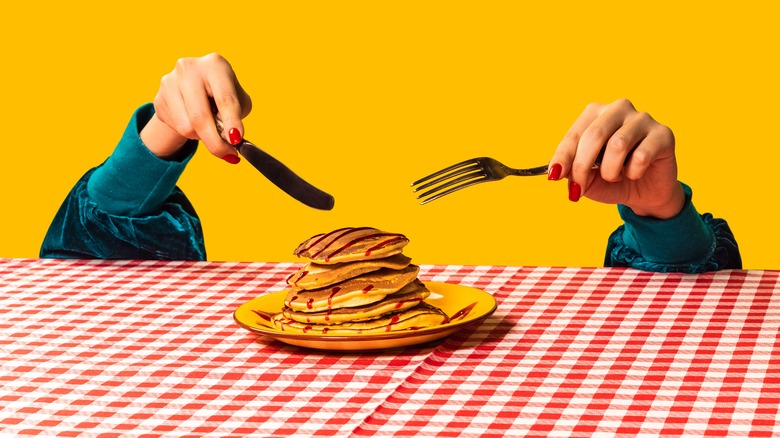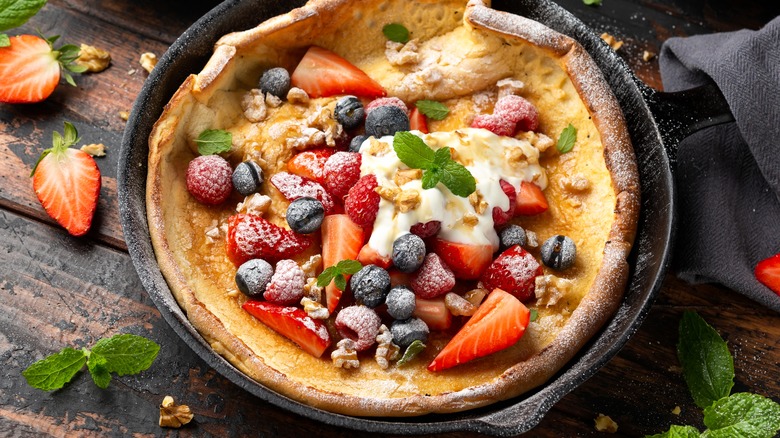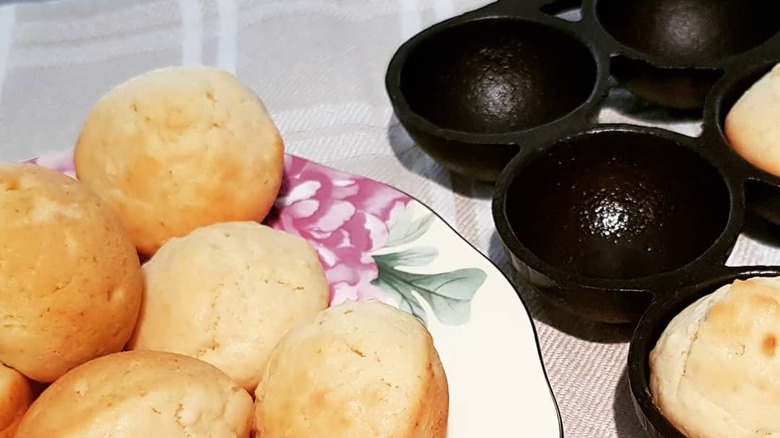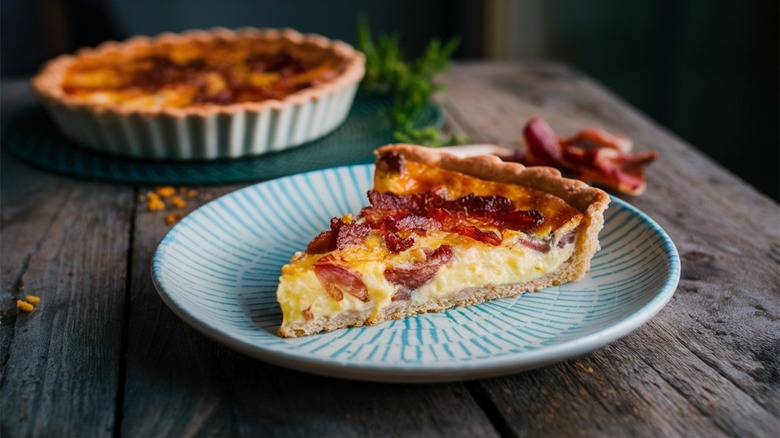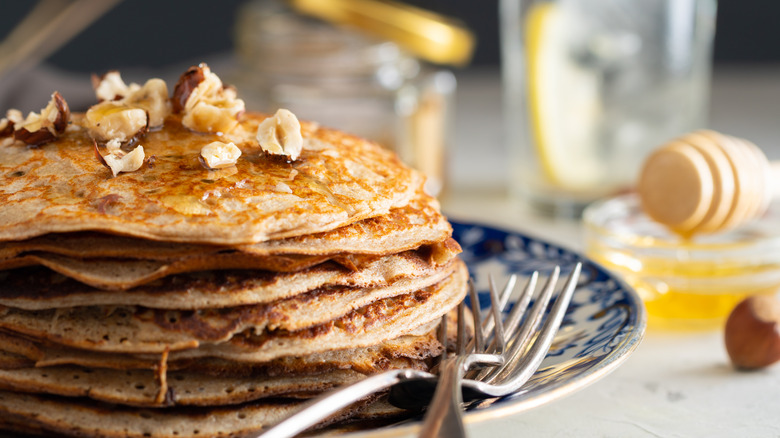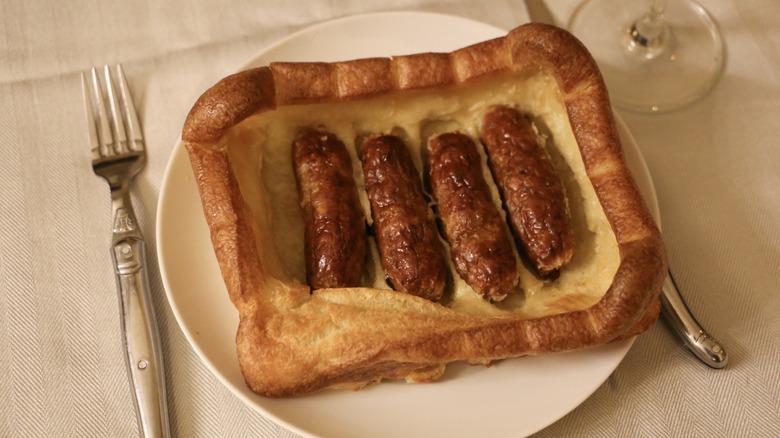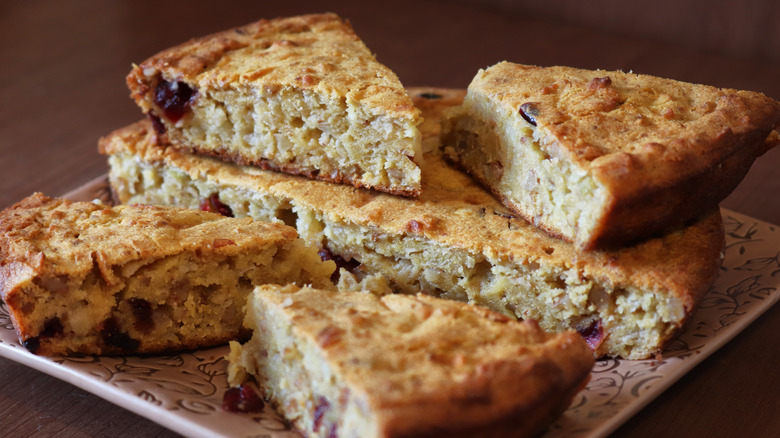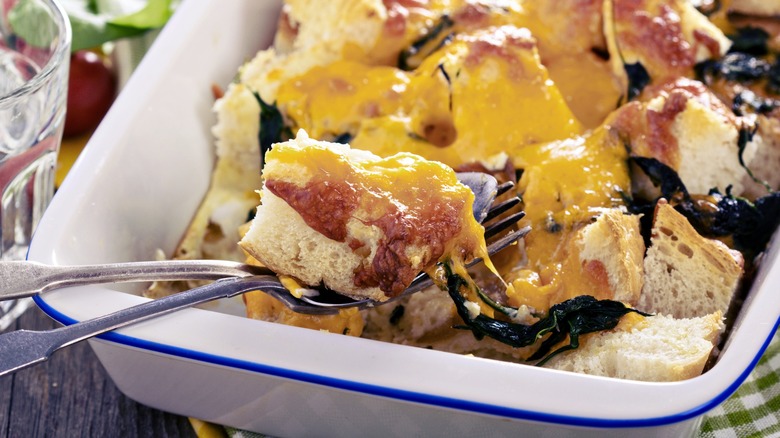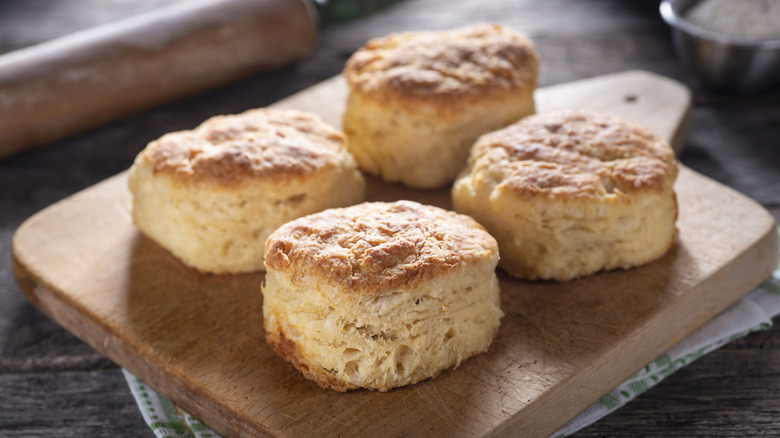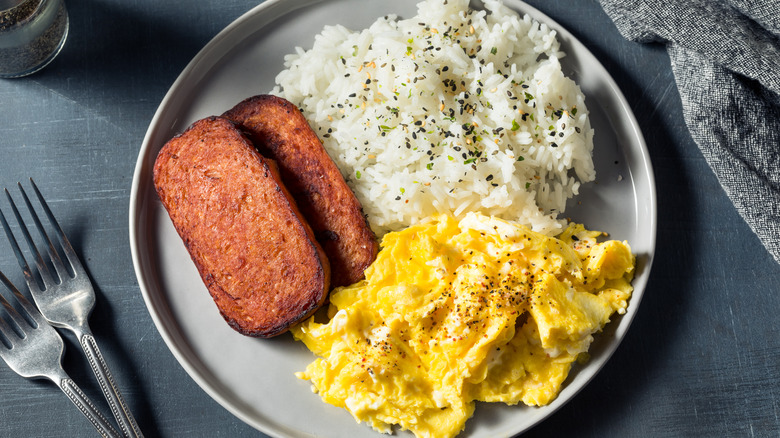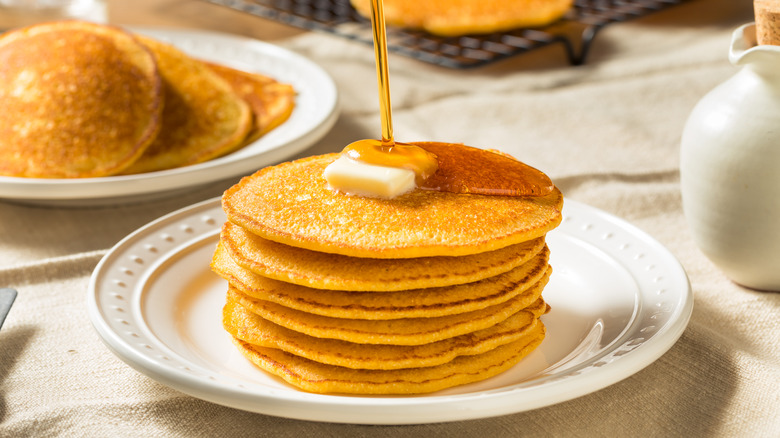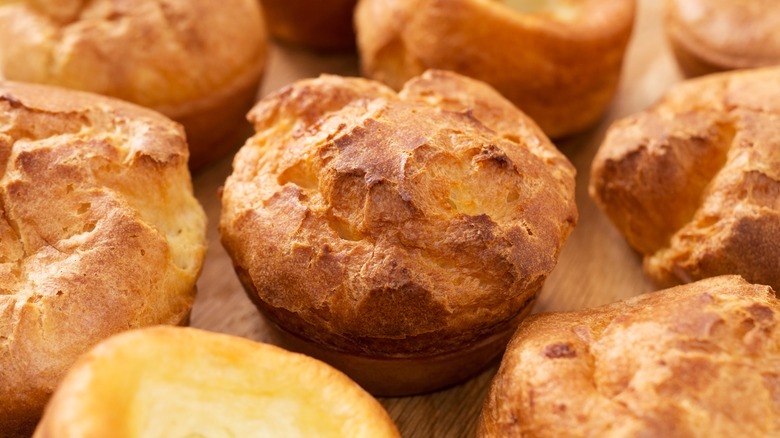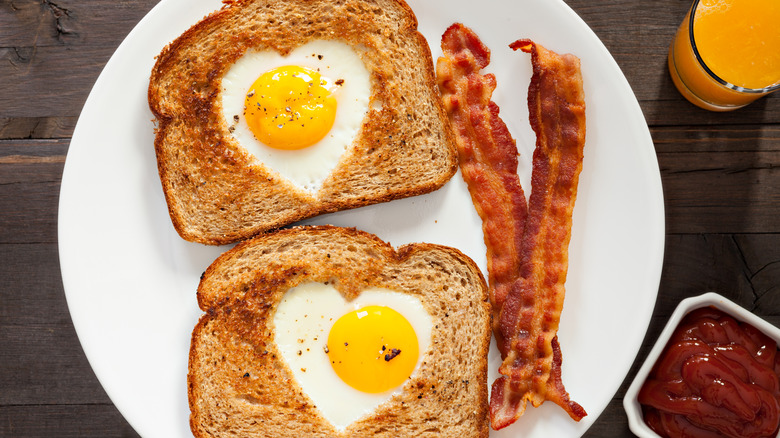12 Old-School Breakfast Foods We Wish Would Make A Comeback
The most important meal of the day has evolved greatly over the years, though there are some key ingredients which remain important elements of a hearty breakfast today. The same mix of meat, eggs, and starchy things has fueled us for centuries, and though many old-fashioned recipes have lost their popularity over the years, some are well-adapted to today's breakfast trends, and many unexpectedly accommodate a variety of alternative diets.
In today's world of fast-paced, on-the-move living, we've lost some of the comfort of a wholesome, good-for-the-soul meal to start the day. There's much delight to dig into with many vintage and retro breakfast recipes that have fallen out of fashion. Some are simple, others decadent, and all would make for a delicious brunch too. With some going back centuries and others merely a few decades, here are 12 old-school breakfast foods, both savory and sweet, that are deserving of a comeback.
1. Dutch baby pancakes
Not so much a pancake, and not at all Dutch, this decadent dessert-like breakfast cooks a bit like a French soufflé and yet has subtle differences to a British Yorkshire pudding, though the dish's origins are purported to be German. Also often called a German pancake, the Dutch baby's name may come from a mispronunciation of "Deutsch" and the earliest evidence of a dish by this name comes from an early 20th century Seattle cafe.
The Dutch baby recipe and execution are so simple it's no wonder this breakfast was a hit, and it's ripe for taking the limelight once again. Making one at home entails little more than pouring the simple batter of flour, milk, eggs, and sweetener into a cast iron skillet — then the whole thing bakes in the oven. The result doesn't resemble much of a pancake at first, as the batter rises to the heights of a soufflé, but then it quickly collapses once removed from the oven. The overall result is a crispy-edged, custardy-centered, crepe-like pancake that gets traditionally topped with powdered sugar and fresh fruit. But the topping possibilities are endless, and the recipe is easily adaptable to savory versions too.
2. Gems
Gems were once considered a health food, falling somewhere between muffins and scones. They were widely popular in the 19th century, though recipes for these breakfast treats seem to have disappeared from contemporary cookbooks. Though commonly made with graham flour back in the day, gems were a versatile breakfast food that could be adapted to use any flour on hand. Fannie Merritt Farmer's popular "The Boston Cooking School Cook Book" lists rye, cornmeal, and hominy among her gem recipes, suggesting that gems are naturally suited to our contemporary demand for alternative baking too. Most gem recipes are minimal, requiring only milk, eggs, and a leavening agent in addition to flour. The batter gets whipped until full of air bubbles for a light and airy outcome. If sweetened, gems typically contain molasses, sugar, or even maple syrup.
Perhaps the reason why gems have disappeared from breakfast options is because the gem pans required to make them are also no longer a household commodity. Patented in 1859, these cast iron pans were shallower than muffin tins, with wells individually separated so that the batter could rise to puff up into a shape and texture that a muffin pan can't quite achieve. While they might not be available everywhere, gem pans aren't impossible to find. Gems would make for a novelty breakfast that's highly adaptable, and more fun than muffins — if made in a proper gem pan, gems puff up into a nice fluffy, round confection.
3. Quiche Lorraine
Quiche Lorraine is traditionally a French meal served more plausibly at dinner than any other time of day, and in Britain it's thought of as a lunch dish. But quiche Lorraine has, in its time, been served for breakfast too, and would make an exceptional brunch item du jour. Reaching popularity in the U.S. and England around the 1950s, quiche Lorraine (and really quiche of any kind) had a midcentury moment, perhaps in part because whipping up a quiche proved not to be as difficult as one might think. While they're no longer mainstream mainstays, there's something equal parts retro and classic about a quiche for breakfast.
Though purists have even simpler recipes — the hearty dish originated as poor man's winter fare in the Lorraine region of eastern France with neither bacon nor cheese — the most well-recognized quiche Lorraine today has evolved into something truly decadent. Filled with cream, cheese, and bacon, quiche Lorraine contains a trinity well suited to a sumptuous breakfast or brunch. No matter what you decide to add to a quiche Lorraine, here are some helpful tips to ensure you get it right. It may not be for everyday baking, but it's worth the occasional indulgence, so here's our simple quiche Lorraine recipe to tempt you.
4. Buckwheat pancakes
A wholesome meal with working-class origins, buckwheat pancakes have an international heritage. Originating in Asia, buckwheat made its way to Europe to become an integral ingredient in many regional European cuisines. In France, Brittany's buckwheat galettes are savory crepes with somewhat mysterious origins. In Germany's Lower Saxony, buckwheat pancakes are a traditional daily staple. Both serve as a nourishing poor man's food, as buckwheat has long been an affordable meal source, growing well in harsher climates.
With the invention of leavening agents in the 19th century, buckwheat pancakes (along with all other forms of pancakes) became a more sophisticated dish that was easier to prepare. By the early 20th century, buckwheat had worked its way into upper-class diets as well. "Buckwheat cakes" were a part of the First Class breakfast on the HMS Titanic which made its fateful transatlantic voyage in 1912.
Wherever the recipes came from, buckwheat pancakes were once a widely consumed breakfast food. Noticeably different to traditional pancakes, due to their darker color, their flavor is also much earthier — even slightly bitter — which may make them an acquired taste for some. But buckwheat makes for a nutritious morning meal, as it is known to lower cholesterol and regulate blood sugar. Despite the name, buckwheat isn't a cereal. It comes from a different family of plants, together with sorrel and rhubarb, and is therefore naturally gluten-free. Buckwheat pancakes would be an especially nutritious choice for a retro morning meal that accommodates many diets.
5. Toad in the Hole
A British specialty since the 18th century, the origins of toad in the hole and its name both remain tantalizingly mysterious. But the dish itself is relatively simple: Meat baked in a Yorkshire pudding that's served with gravy. Most recognizably, this means sausages peeping out of the pudding (something non-Brits might never guess behind the name), but technically any meat will do. Many types of meat have been used throughout the history of this dish, either inspired by thriftiness in using up leftover meat scraps to stretch meals or due to cooks' creativity during times of general scarcity — spam, for example, featured in toad in the hole during World War II.
Though not strictly a breakfast item, toad in the hole incorporates all the elements to make a hearty first meal of the day. Yorkshire pudding, a savory mixture of milk, flour, and eggs, crispy on the outside, soft on the inside, bakes into a sort of popover. It pairs deliciously with sausages for a unique take on breakfast or brunch that doesn't require much more than mixing before it goes into the oven.
6. Corn pone bread
Corn pone has its origins in Native American cuisine, coming from traditionally unleavened cornmeal cakes cooked over ashes. The name "pone" is likely a mispronunciation of indigenous terms for this staple, such as appone or ponap. True corn pone of this traditional variety looks a little like golden pancakes and has only a few simple ingredients: Cornmeal, salt, water, and a fat of some kind. But American colonists quickly adapted the recipe into a diverse assembly of cornbread-adjacent dishes.
Though it can be consumed at any time of day, corn pone was often a colonial breakfast food and remains a regional specialty of the South. Though the term is sometimes used interchangeably with cornbread, corn pones are more traditionally savory. Either fried or baked in a cast iron skillet, corn pone is typically softer on the inside, with a crispy exterior. This dish isn't necessarily renowned for its flavor, but is a blank canvas for sweet and savory flavor profiles. Corn pone is a true traditional meal and makes an adaptable side dish, but is hearty enough to be a main course too. Easy to whip up, corn pone would be an intriguing addition to the breakfast table, and recipes can get creative, with anything mixed into the batter.
7. Strata
This American breakfast invention is a sort of casserole cross between quiche and bread pudding. One of the earliest recorded recipes for a "Cheese Strata" which consists of layered bread, white sauce, and cheese baked in a casserole dish dates to 1902, from Juanita L. Shepperd's "Handbook of Household Sciences." Published in Minnesota, this cookbook recipe suggests that stratas were certainly being baked throughout the 20th century, especially in the Midwest. But the dish became something more widely popularized when variations appeared in later recipes. The strata had a moment in the 1980s, with its appearance in Sheila Lukins and Julee Rosso's Silver Palate Cookbook, a culinary guide that helped American cooking evolve into the international melange it is today. Gourmet Magazine also featured strata in the 1980s as a Christmas breakfast recipe, but the dish can easily be enjoyed year-round.
Today, stratas are more commonly akin to savory bread puddings made with the typical combination of bread pieces, eggs, and cheese. While this is guaranteed to be delicious, the strata merits a comeback for the fact this it's also quite adaptable. All you need to spice up the recipe is added meat or vegetables, or perhaps a mix of different spices for a twist on the classic. To make a strata, all that's required is layering the ingredients and baking them in the oven, making breakfast or brunch easier than ever.
8. Homemade biscuits
Homemade biscuits used to be the heart of many American breakfasts, though they were labor-intensive to prepare before the invention of leavening agents. Biscuits have a history as complicated as the process of beating the batter that was once required to make them. At the height of their popularity in the early 19th century, before baking powder and baking soda came into the picture, it took an hour of beating to get biscuit batter light and airy. This meant biscuits were usually prepared by enslaved workers, and they became less commonly consumed after the abolition of slavery.
The invention of biscuit mix and ready-to-bake dough in the early 20th century has added some measure of convenience back into the biscuit-baking process. Still a Southern staple, biscuits today seem to have less widespread associations with breakfast than as an accompaniment to a hearty dinner. Fresh from the oven and slathered with butter and jam, who wouldn't enjoy starting their day with something full of such simple deliciousness? When pre-prepared biscuit dough and mixes can taste just as good as true from-scratch baking, it's easier than ever to whip up a batch of biscuits for breakfast anytime.
9. Spam
Spam, the mysterious miracle meat made from pork, potato starch, salt, and sugar, was popularized during World War II, and still reigns in sandwiches worldwide. But spam was once eaten as a breakfast item too, and could be a supplement to bacon or sausages any day of the week.
Today, spam still remains a popular breakfast item in Hawaii, a legacy of World War II's impact on the island and its resources. Spam for breakfast in Hawaii is usually fried with soy sauce and typically served with eggs and rice. That combo alone is a tasty enough reason to try it for breakfast, but spam is an ingredient so adaptable it could be an intriguing addition to anything savory. Add it chopped up to casseroles or omelets, or serve it fried on the side. Mid-20th century ad campaigns once even suggested serving spam and waffles together. With something that's convenient to prepare and keeps well in the pantry, spam could change the face of any classic breakfast or brunch.
10. Johnny cakes
Johnny cakes go back to (and perhaps even predate) colonial times in New England. Purists dispute the kind of corn and the type of liquid that goes into making the mixture, but the end result is a cornmeal batter that gets fried into crispy, golden cornmeal pancakes. The name, however, has no sure origin. Some believe that the term Johnny cakes comes from a linguistic evolution of "journeycakes" as these portable patties were also once eaten as meals on the go. Other accounts suggest that the name could be a misnomer for "Shawnee cakes", named for the tribe that may have been cooking up these cakes before the colonists.
Believed to have originated in Rhode Island, Johnny cakes' popularity remains centered there. But these pancakes are a taste of history to be enjoyed anywhere, and simpler than more traditional flour pancakes to whip up. Enjoyed throughout American history as part of any meal of the day, these cakes are neutral enough to be enjoyed as a breakfast meal anytime when paired with butter and syrup, or accompanying savory meats. Since they are made with cornmeal, Johnny cakes are also naturally gluten-free, which puts a traditional twist on alternative breakfast cooking.
11. Popovers
While they greatly resemble the British side dish Yorkshire pudding, popovers are an American adaptation of this British classic. The main difference distinguishing the two savory pastries is what gets used to grease the baking tin. Tins for Yorkshire pudding are typically greased with beef drippings, whereas popover tins are traditionally greased with butter. The former is thus better suited to accompany savory meals, the latter versatile enough to accompany savory or sweet.
Made from a simple batter of milk, eggs, and flour, popovers are baked in a butter-greased muffin tin (or something specialized that's a bit deeper). These pastries pop over the top of the tin as they rise in the oven, hence their name. The end result is a sort of muffin with a consistency more like a soufflé — light and airy, crispy on the outside and softer within. The popover's Yorkshire cousin is usually served as a side dish with meat, and popovers are well adapted to the same role. But as an American variation, popovers have more typically been served for breakfast, and make for something with more novelty than muffins, biscuits, or scones to serve with jam, butter, or any other spread.
12. Egg in a hole
While it may not be apparent exactly where egg in a hole comes from, the concept of this dish has been prepared across cultures for decades, even centuries. It has as many names as it does origins, since various cultures had their own versions of the recipe which they may have brought with them when they immigrated to the U.S. The basic concept is delightfully simple — a fried egg cooked in a hole cut out of a piece of toast. "Egg in the basket" and "egg with a hat" are two popular variations of name and form, the latter entailing the egg-in-toast dish to be topped with the "hat" circle of bread that initially gets cut out.
Egg in a hole may have taken off as a breakfast novelty during the 20th century's advancements toward convenience. When sliced bread was first introduced to the public at the end of the 1920s, it set the stage for the recognizable base from which we make egg in a hole today. A dish many regard with nostalgia, egg in a hole is such a simple breakfast and inspires such delight that it certainly deserves a comeback.
